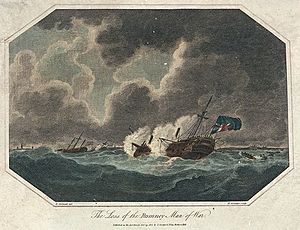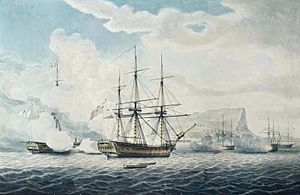HMS Romney (1762) facts for kids
class="infobox " style="float: right; clear: right; width: 315px; border-spacing: 2px; text-align: left; font-size: 90%;"
| colspan="2" style="text-align: center; font-size: 90%; line-height: 1.5em;" | 
|} HMS Romney was a 50-gun warship of the Royal Navy. She was known as a "fourth-rate" ship, meaning she was a medium-sized warship. Romney served for 40 years, taking part in the American War of Independence, and the French Revolutionary and Napoleonic Wars. Five ships of the Royal Navy have been named Romney. The name comes from the town of New Romney in England.
Launched in 1762, Romney spent much of her early time in North America. She was often the main ship, or flagship, for the commander there. The ship played a role in the events leading up to the American Revolution. In 1768, she was sent to Boston to help officials enforce new tax laws called the Townshend Acts. Her crew forced local sailors to join the navy, which was called impressment. They also took a ship belonging to a famous American, John Hancock. When riots broke out, the officials had to hide on Romney.
Romney stayed in American waters for part of the war. Later, she moved to European waters when France joined the conflict. After the wars, Romney was often kept in storage or repaired. But she returned to active duty when war broke out with Revolutionary France. In 1793, she was in the Mediterranean Sea, helping with the British takeover of Toulon. During this time, she captured a French warship called Sibylle. Romney later served in North America and the Red Sea. In November 1804, while blocking the Dutch coast, Romney got stuck on a sandbank. She broke apart after attempts to free her failed.
Contents
- Serving in North America
- During the American War of Independence
- Battles in the French Revolutionary Wars
| History | |
|---|---|
| Name | Romney |
| Ordered | 20 July 1759 |
| Builder | Woolwich Dockyard |
| Laid down | 1 October 1759 |
| Launched | 8 July 1762 |
| Completed | By 4 September 1762 |
| Honours and awards |
|
| Fate | Lost on 19 November 1804 |
| General characteristics | |
| Class and type | 50-gun fourth rate |
| Tons burthen | 1,02834⁄94 bm |
| Length |
|
| Beam | 40 ft (12.2 m) |
| Depth of hold | 17 ft 2 in (5.2 m) |
| Propulsion | Sails |
| Sail plan | Full-rigged ship |
| Complement | 350 |
| Armament |
|
Building the Ship
HMS Romney was designed by Sir Thomas Slade. Her design was special and unique. She was ordered on 20 July 1759 from Woolwich Dockyard. Her construction began there on 1 October 1759. The ship was built by Master Shipwright Israel Pownoll. She was launched into the water on 8 July 1762. Romney was fully ready for service by 4 September 1762.
Adventures at Sea
Serving in North America
HMS Romney began her service in August 1762. Her first commander was Captain Robert Walsingham. She was taken out of service briefly but returned in June 1763 under Captain James Ferguson. Romney became the flagship for Rear-Admiral Lord Colvill, the commander in North America. She served as his main ship for three years.
In March 1767, Romney returned to North America under Captain John Corner. She was sent to Boston Harbour to help officials enforce the Townshend Acts. These acts were new taxes on goods imported into the American colonies. When Romney arrived, she needed more sailors. Captain Corner began to impress seamen from the harbour. This meant forcing local sailors to join the navy, which made the people of Boston very angry.
Things got worse when officials ordered the seizure of a merchant ship called Liberty. This ship belonged to John Hancock, a wealthy American merchant. When sailors and marines from Romney tried to take the ship, angry crowds attacked them. The officials then had to seek safety aboard Romney. These events increased the tension that later led to the Boston Massacre in 1770.
During the American War of Independence
In 1770, Captain Hyde Parker briefly commanded Romney. She was then taken out of service for repairs between 1773 and 1775. She returned to duty in April 1775 under Captain George Elphinstone. Romney became the flagship for the commander of the Newfoundland station, Rear-Admiral Robert Duff.
Later, Captain George Johnstone took command in 1779. Romney sailed in the English Channel. She was involved in defending Britain during an attempted invasion by France and Spain. After this, she sailed to Lisbon. On 11 November 1779, Romney and another British ship captured a Spanish frigate called Santa Margarita. This Spanish ship was then added to the British navy.
In 1780, Romney captured two French ships off Cape Finisterre. These were the 38-gun Artois and the 18-gun Perle. In March 1781, Johnstone sailed to the East Indies with a group of ships. Romney took part in the Battle of Porto Praya on 16 April 1781. This battle did not have a clear winner. However, on 21 July, Romney helped capture several Dutch merchant ships in Saldanha Bay.
Romney returned to Britain in November 1781. After more repairs, she returned to duty in March 1792. She served in the Mediterranean Sea until the French Revolutionary Wars began. In March 1793, she joined the British forces occupying Toulon.
Battles in the French Revolutionary Wars

On 17 June 1794, while sailing near Mykonos, Captain William Paget on Romney saw a French warship in the harbour. Paget demanded that the French ship surrender. The French captain refused. Romney and the French ship then fought for over an hour. The French ship, which was the 44-gun frigate Sibylle, finally gave up. The Sibylle had 46 sailors killed and 112 wounded. Romney had 8 sailors killed and 30 wounded in this Battle of Mykonos. Years later, in 1847, surviving sailors from Romney received the Naval General Service Medal for this battle.
Romney then sailed back to Britain. She later became the flagship for Vice-Admiral Sir James Wallace and returned to Newfoundland. For several years, she sailed between Britain and Newfoundland.
Final Years and Loss
In March 1798, Captain John Lawford took command. In August 1799, Romney was part of a squadron in Den Helder during the Vlieter Incident. Captain Sir Home Popham took over in August 1800. He sailed Romney to the Red Sea. There, she supported British forces trying to remove the French from Egypt. Because Romney was part of this campaign, her crew later received the "Egypt" clasp for their Naval General Service Medal.
In 1802, Romney was still in the Red Sea. She helped General Baird's expedition. On 14 June, a transport ship called Calcutta crashed on the Egyptian coast. It was carrying 331 soldiers and 79 Indian followers. Romney arrived the next day. Her boats were able to rescue all but seven men who had died trying to reach shore earlier.
After repairs in 1803, Captain William Brown recommissioned Romney. She was to operate off the African coast and in the West Indies. Captain John Colville became her commander in October 1804.
The Loss of Romney
On 18 November 1804, Romney sailed from Yarmouth. She was going to join a group of ships blocking the Texel in the Netherlands. The next day, she ran aground (got stuck) on the Haak bank. This happened because her pilots got lost in thick fog. Attempts to free the ship failed.
Captain Colvill realized his ship was doomed. He sent out two boats to find help from nearby merchant ships. One boat flipped over on its way back, and its crew drowned. The other boat went to shore, hoping to get help from the Dutch authorities. The next morning, Romney was breaking apart quickly. Colvill oversaw the building and launching of rafts to save his men.
As the last raft was being launched, seven Dutch boats approached from shore. The Dutch commander asked Colvill to surrender, promising to save the British sailors. Colvill agreed, and the Dutch rescued the remaining crew. In total, between nine and eleven men were lost in the wreck.
The Dutch took the British sailors to shore. Dutch Admiral Kirkhurt treated them well. He then sent Captain Colvill and eight of his officers back to join the British fleet.
Later, Captain Colvill faced a court martial (a military trial) for the loss of his ship. This was standard practice. The court found him, his officers, and his men not guilty. They decided the accident was caused by the thick fog and the pilots' lack of knowledge. The pilots lost their pay and were forbidden from guiding any of His Majesty's ships. They were also briefly imprisoned.

